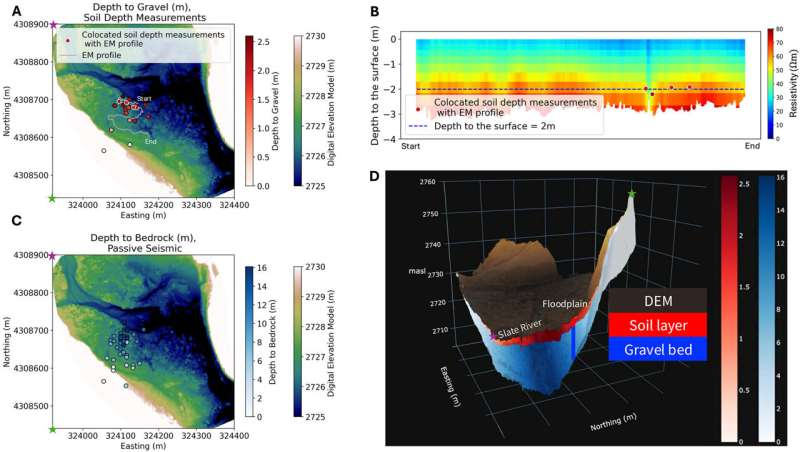How Beavers Shape Ecosystems Above and Below the Ground

Beavers have long been celebrated as ecosystem engineers, famous for building dams that transform streams into lush wetlands. But a new study led by Lijing Wang from the University of Connecticut’s Department of Earth Sciences goes deeper—literally. Published in Water Resources Research (2025), Wang’s team examined how beaver ponds influence not just the visible landscape but also the hidden subsurface world of soils and groundwater.
Their work reveals a fascinating picture: beavers don’t just change how rivers look or where water pools on the surface—they also alter how water moves underground, how groundwater is recharged, and even how water quality might shift depending on what lies beneath.
What the Study Looked At
The researchers wanted to understand how beaver-made ponds affect the movement of groundwater and the subsurface hydrology of floodplains. Groundwater often feeds streams, especially late in the summer when surface water is scarce. Knowing how beaver ponds interact with groundwater is crucial for water management, restoration efforts, and climate resilience planning.
To explore this, the study combined several advanced techniques:
- Geophysical surveys and hydrologic measurements were conducted to map the underground layers, such as the depth to the gravel bed and bedrock.
- A hydrologic model was created to simulate how water flows through these layers under different conditions.
- A machine learning method called a neural density estimator—a tool first used in astrophysics—was applied to calibrate the model and improve predictions about water movement.
This combination of fieldwork, modeling, and AI calibration gave the researchers a powerful new lens to see how beaver activity affects both surface and underground water systems.
Where and How the Study Was Conducted
The field site for this research was in the Rocky Mountains, an area characterized by rivers with gravel bed systems. These gravel layers are made of large cobbles and stones that can extend as deep as 16 meters below the surface and spread outward beneath the floodplain.
Wang’s team focused on how water behaved under different subsurface structures. They created models that represented various combinations of soil layer thickness and gravel bed depth to see how these physical features affected groundwater movement when a beaver pond flooded the area.
The findings were eye-opening: characterizing the floodplain’s structure turned out to be one of the most critical factors in understanding how beaver ponds change the flow of water underground.
What They Found Beneath the Surface
When beavers flood an area, their ponds cause a dramatic increase in groundwater recharge—up to ten times higher compared to dry conditions. That means beaver ponds help push more water from the surface into the ground, replenishing aquifers and increasing water availability.
However, there’s a catch. The team discovered that once the water seeps down to the gravel bed, it doesn’t stay put. Instead, it flows downstream through the subsurface, like a hidden underground river. So while beaver ponds do help recharge groundwater, they may not necessarily boost the local water table right beneath the pond. The water continues its journey below the surface, feeding ecosystems further downstream.
The researchers also examined evapotranspiration (ET)—the process by which water evaporates from soil and transpires through plants. In regions where the soil layer above the gravel bed is thick, more water evaporates or gets used by vegetation. That means the groundwater recharge effect might actually be smaller or even reversed, depending on how much water is lost to the air.
In simpler terms: the benefits of beaver ponds on groundwater depend heavily on what’s underneath. Thin soil layers allow more water to seep downward, while thick soils cause more water to evaporate instead.
Beyond Water Quantity: Water Quality and Risks
While beaver ponds can boost biodiversity and water storage, Wang’s research also warns of potential downsides related to water quality. When beavers slow the flow of water, oxygen levels in the soil and pond sediment often drop. These anoxic (low-oxygen) conditions can encourage the growth of anaerobic bacteria—organisms that thrive without oxygen and can mobilize heavy metals trapped in sediments.
In untouched, natural environments, this might not be a big issue. But in regions with a history of mining or industrial activity, like the Colorado study site, these bacteria can make toxic metals more soluble, allowing them to move downstream and potentially harm aquatic life.
So while beavers bring many ecological benefits, including wetland creation and wildfire resilience, their ponds can also change the chemistry of groundwater in ways that require careful study and monitoring.
Expanding the Research
Although this study focused on Colorado, Wang and her team have started applying the same methods in New England. The hydrological landscape there is much more complex, with denser river networks, more tributaries, and more beaver dams per watershed. Understanding how beaver activity interacts with these intricate systems could help explain why New England’s wetlands and floodplains are so biologically rich and climate-resilient.
The researchers emphasize that to truly manage water resources effectively, scientists and policymakers must consider both above- and below-ground processes. The effects of beavers are not uniform—they depend on local geology, land use history, and even climate conditions.
Why Beaver Ponds Matter for Modern Water Management
This research isn’t just academic curiosity. As the western United States faces increasing droughts and wildfires, land managers are turning to beaver dam analogs (BDAs)—human-made structures that mimic natural beaver dams—to help restore wetlands, slow water flow, and store more moisture in the landscape.
But as Wang’s work shows, simply adding ponds without understanding the subsurface structure can lead to misleading results. In some places, ponds might recharge groundwater efficiently; in others, they could just increase evaporation.
In short, the geology beneath a wetland is just as important as what happens on the surface.
What Makes Beavers Ecosystem Engineers
Beavers have earned their title as ecosystem engineers because of their ability to reshape landscapes. By building dams, they create wetlands that:
- Increase biodiversity by offering habitats for birds, amphibians, and fish.
- Store carbon by slowing decomposition in wet soils.
- Mitigate floods by holding back stormwater and releasing it gradually.
- Recharge aquifers and filter pollutants, improving water quality over time.
Historically, millions of beavers once inhabited North America, maintaining vast wetland systems. Their near-extinction during the fur trade dramatically changed hydrology and ecosystem dynamics. As beaver populations rebound, scientists are rediscovering just how vital their engineering skills are—not just for wildlife, but for climate resilience and water management.
The Takeaway
This new research gives a much clearer picture of how beaver activity links surface water, groundwater, and the hidden subsurface geology. Beaver ponds can significantly enhance groundwater recharge, but the magnitude and outcome depend on floodplain structure, soil thickness, and hydrologic conditions.
They remind us that even the smallest creatures can have profound effects on entire ecosystems, extending far beyond what we can see on the surface. Understanding those effects can help us design better restoration projects, protect water quality, and anticipate how ecosystems will respond to climate change.





